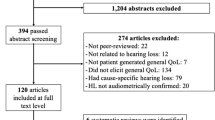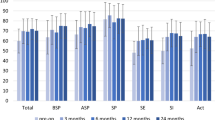Abstract
Purpose
The aim of this study was to compare two preference-weighted, caregiver-reported measures of health-related quality of life for children with permanent childhood hearing loss to determine whether cost-effectiveness analysis applied to deaf and hard of hearing populations will provide similar answers based on the choice of instrument.
Methods
Caregivers of 103 children in Arkansas, USA, with documented hearing loss completed the Quality of Well-Being Scale (QWB) and the Health Utilities Index Mark 3 (HUI3) to describe the health status of their children. Audiology and other clinical measures were abstracted from medical records. Mean scores were compared overall and by degree of hearing loss. Linear regression was used to correlate preference scores with a four-frequency pure-tone average, cochlear implant status, and other factors.
Results
Mean preference scores for the QWB and HUI3 were similar (0.601 and 0.619, respectively) although the HUI3 demonstrated a wider range of values (−0.132 to 1.000) compared to the QWB (0.345–0.854) and was more sensitive to mild hearing loss. Both measures correlated with the pure-tone average, were negatively associated with comorbid conditions and positively associated with cochlear implant status. In the best fitting regression models, similar estimates for cochlear implant status and comorbid conditions were obtained from the two measures.
Conclusions
Despite considerable differences in the HUI3 and the QWB scale, we found agreement between the two instruments at the mean, but clinically important differences across a number of measures. The two instruments are likely to yield different estimates of cost-effectiveness ratios, especially for interventions involving mild to moderate hearing loss.

Similar content being viewed by others
References
Dalton, D. S., Cruickshanks, K. J., Klein, B. E., Klein, R., Wiley, T. L., & Nondahl, D. M. (2003). The impact of hearing loss on quality of life in older adults. Gerontologist, 43, 661–668.
Pugh, K. C. (2004). Health status attributes of older African-American adults with hearing loss. Journal of the National Medical Association, 96, 772–779.
Wake, M., Hughes, E. K., Collins, C. M., & Poulakis, Z. (2004). Parent-reported health-related quality of life in children with congenital hearing loss: A population study. Ambulatory Pediatrics, 4, 411–417. doi:10.1367/A03-191R.1.
Stacey, P. C., Fortnum, H. M., Barton, G. R., & Summerfield, A. Q. (2006). Hearing-impaired children in the United Kingdom, I: Auditory performance, communication skills, educational achievements, quality of life, and cochlear implantation. Ear and Hearing, 27, 161–186. doi:10.1097/01.aud.0000202353.37567.b4.
Cheng, A. K., Rubin, H. R., Powe, N. R., Mellon, N. K., Francis, H. W., & Niparko, J. K. (2000). Cost-utility analysis of the cochlear implant in children. Journal of the American Medical Association, 284, 850–856. doi:10.1001/jama.284.7.850.
Huber, M. (2005). Health-related quality of life of Austrian children and adolescents with cochlear implants. International Journal of Pediatric Otorhinolaryngology, 69, 1089–1101. doi:10.1016/j.ijporl.2005.02.018.
Moeller, M. P., Hoover, B., Putman, C., Arbataitis, K., Bohnenkamp, G., Peterson, B., Lewis, D., Estee, S., Pittman, A., & Stelmachowicz, P. (2007). Vocalizations of infants with hearing loss compared with infants with normal hearing. Part II. Transition to words. Ear and Hearing, 28, 628–642. doi:10.1097/AUD.0b013e31812564c9.
Moeller, M. P., Hoover, B., Putman, C., Arbataitis, K., Bohnenkamp, G., Peterson, B., Wood, S., Lewis, D., Pittman, A., & Stelmachowicz, P. (2007). Vocalizations of infants with hearing loss compared with infants with normal hearing. Part I. Phonetic development. Ear and Hearing, 28, 605–627. doi:10.1097/AUD.0b013e31812564ab.
Puig, T., Municio, A., & Meda, C. (2005). Universal neonatal hearing screening versus selective screening as part of the management of childhood deafness. Cochrane Database Systematic Review, CD003731.
Bess, F. H., & Paradise, J. L. (1994). Universal screening for infant hearing impairment: Not simple, not risk-free, not necessarily beneficial, and not presently justified. Pediatrics, 93, 330–334.
Thompson, D. C., McPhillips, H., Davis, R. L., Lieu, T. L., Homer, C. J., & Helfand, M. (2001). Universal newborn hearing screening: Summary of evidence. Journal of the American Medical Association, 286, 2000–2010. doi:10.1001/jama.286.16.2000.
Kennedy, C. R., McCann, D. C., Campbell, M. J., Law, C. M., Mullee, M., Petrou, S., Watkin, P., Worsfold, S., Yuen, H. M., & Stevenson, J. (2006). Language ability after early detection of permanent childhood hearing impairment. New England Journal of Medicine, 354, 2131–2141. doi:10.1056/NEJMoa054915.
Schroeder, L., Petrou, S., Kennedy, C., McCann, D., Law, C., Watkin, P. M., Worsfold, S., & Yuen, H. M. (2006). The economic costs of congenital bilateral permanent childhood hearing impairment. Pediatrics, 117, 1101–1112. doi:10.1542/peds.2005-1335.
Yoshinaga-Itano, C. (1999). Benefits of early intervention for children with hearing loss. Otolaryngologic Clinics of North America, 32, 1089–1102. doi:10.1016/S0030-6665(05)70196-1.
Downs, M. P., & Yoshinaga-Itano, C. (1999). The efficacy of early identification and intervention for children with hearing impairment. Pediatric Clinics of North America, 46, 79–87. doi:10.1016/S0031-3955(05)70082-1.
Gold, M. R., Siegel, J. E., Russell, L. B., & Weinstein, M. C. (1996). Cost-effectiveness in health and medicine. New York, Oxford: Oxford University Press.
Neumann, P. J., Goldie, S. J., & Weinstein, M. C. (2000). Preference-based measures in economic evaluation in health care. Annual Review of Public Health, 21, 587–611. doi:10.1146/annurev.publhealth.21.1.587.
Gold, M. R., Patrick, D. L., Hadorn, D. C., Kamlet, M. S., Torrance, G. W., Fryback, D. G., Daniels, N., & Weinstein, M. C. (1996). Identifying and valuing outcomes. In M. R. Gold, J. E. Siegel, L. B. Russell, & M. C. Weinstein (Eds.), Cost-effectiveness in health and medicine (pp. 82–134). New York, Oxford: Oxford University Press.
UK Cochlear Implant Study Group. (2004). Criteria of candidacy for unilateral cochlear implantation in postlingually deafened adults III: Prospective evaluation of an actuarial approach to defining a criterion. Ear and Hearing, 25, 361–374. doi:10.1097/01.AUD.0000134551.13162.88.
Bichey, B. G., Hoversland, J. M., Wynne, M. K., & Miyamoto, R. T. (2002). Changes in quality of life and the cost-utility associated with cochlear implantation in patients with large vestibular aqueduct syndrome. Otology and Neurotology, 23, 323–327. doi:10.1097/00129492-200205000-00016.
Summerfield, A. Q., Marshall, D. H., Barton, G. R., & Bloor, K. E. (2002). A cost-utility scenario analysis of bilateral cochlear implantation. Archives of Otolaryngology-Head and Neck Surgery, 128, 1255–1262.
Palmer, C. S., Niparko, J. K., Wyatt, J. R., Rothman, M., & de Lissovoy, G. (1999). A prospective study of the cost-utility of the multichannel cochlear implant. Archives of Otolaryngology-Head and Neck Surgery, 125, 1221–1228.
Cheng, A. K., & Niparko, J. K. (1999). Cost-utility of the cochlear implant in adults: A meta-analysis. Archives of Otolaryngology-Head and Neck Surgery, 125, 1214–1218.
Wyatt, J. R., Niparko, J. K., Rothman, M., & deLissovoy, G. (1996). Cost utility of the multichannel cochlear implants in 258 profoundly deaf individuals. Laryngoscope, 106, 816–821. doi:10.1097/00005537-199607000-00006.
Wyatt, J. R., Niparko, J. K., Rothman, M. L., & DeLissovoy, G. V. (1995). Cost-effectiveness of the multichannel cochlear implant. The Annals of Otology, Rhinology, and Laryngology Supplement, 166, 248–250.
Lee, H. Y., Park, E. C., Kim, H. J., Choi, J. Y., & Kim, H. N. (2006). Cost-utility analysis of cochlear implants in Korea using different measures of utility. Acta Otolaryngologica, 126, 817–823. doi:10.1080/00016480500525213.
Barton, G. R., Stacey, P. C., Fortnum, H. M., & Summerfield, A. Q. (2006). Hearing-Impaired children in the United Kingdom. IV. Cost-effectiveness of pediatric cochlear implantation. Ear and Hearing, 27, 575–588. doi:10.1097/01.aud.0000233967.11072.24.
O’Brien, B. J., Spath, M., Blackhouse, G., Severens, J. L., Dorian, P., & Brazier, J. (2003). A view from the bridge: Agreement between the SF-6D utility algorithm and the Health Utilities Index. Health Economics, 12, 975–981. doi:10.1002/hec.789.
Brazier, J., Roberts, J., Tsuchiya, A., & Busschbach, J. (2004). A comparison of the EQ-5D and SF-6D across seven patient groups. Health Economics, 13, 873–884. doi:10.1002/hec.866.
Hatoum, H. T., Brazier, J. E., & Akhras, K. S. (2004). Comparison of the HUI3 with the SF-36 preference based SF-6D in a clinical trial setting. Value Health, 7, 602–609. doi:10.1111/j.1524-4733.2004.75011.x.
Marra, C. A., Woolcott, J. C., Kopec, J. A., Shojania K, Offer, R., Brazier, J. E., Esdaile, J. M., & Anis, A. H. (2005). A comparison of generic, indirect utility measures (the HUI2, HUI3, SF-6D, and the EQ-5D) and disease-specific instruments (the RAQoL and the HAQ) in rheumatoid arthritis. Social Science & Medicine, 60, 1571–1582. doi:10.1016/j.socscimed.2004.08.034.
Marra, C. A., Esdaile, J. M., Guh, D., Kopec, J. A., Brazier, J. E., Koehler, B. E., Chalmers, A., Anis, A. H. (2004). A comparison of four indirect methods of assessing utility values in rheumatoid arthritis. Medical Care, 42, 1125–1131. doi:10.1097/00005650-200411000-00012.
Barton, G. R., Bankart, J., & Davis, A. C. (2005). A comparison of the quality of life of hearing-impaired people as estimated by three different utility measures. International Journal of Audiology, 44, 157–163. doi:10.1080/14992020500057566.
Barton, G. R., Bankart, J., Davis, A. C., & Summerfield, Q. A. (2004). Comparing utility scores before and after hearing-aid provision: Results according to the EQ-5D, HUI3 and SF-6D. Applied Health Economics and Health Policy, 3, 103–105. doi:10.2165/00148365-200403020-00006.
Kaplan, R. M., & Anderson, J. P. (1996). The general health policy model: An integrated approach. In B. Spiker (Ed.), Quality of life and pharmeaeconomics in clinical trials (pp. 309–322). Philadelphia: Lippincott-Raven.
Kaplan, R. M., & Anderson, J. P. (1988). A general health policy model: Update and Applications. Health Services Research, 23, 203–235.
Feeny, D., Furlong, W., & Torrance, G. (2002). Multiattribute and single-attribute utility functions for the Health Utilities Index Mark 3 system. Medical Care, 40, 113–128. doi:10.1097/00005650-200202000-00006.
Brazier, J., Roberts, J., & Deverill, M. (2002). The estimation of a preference-based measure of health from the SF-36. Journal of Health Econonmics, 21, 271–292. doi:10.1016/S0167-6296(01)00130-8.
Pyne, J. M., Sullivan, G., Kaplan, R., & Williams, D. K. (2003). Comparing the sensitivity of generic effectiveness measures with symptom improvement in persons with schizophrenia. Medical Care, 41, 208–217. doi:10.1097/00005650-200302000-00003.
Marra, C. A., Marion, S. A., Guh, D. P., Najafzadeh, M., Wolfe, F., Esdaile, J. M., Clarke, A. E., Gignac, M. A., & Anis, A. H. (2007). Not all “quality-adjusted life years” are equal. Journal of Clinical Epidemiology, 60, 616–624. doi:10.1016/j.jclinepi.2006.09.006.
Parsons, S. K., Barlow, S. E., Levy, S. L., Supran, S. E., & Kaplan, S. H. (1999). Health-related quality of life in pediatric bone marrow transplant survivors: According to whom? International Journal of Cancer. Supplement, 12, 46–51. doi:10.1002/(SICI)1097-0215(1999)83:12±≤46::AID-IJC9≥3.0.CO;2-C.
Acknowledgements
This project was supported under a cooperative agreement from the Centers for Disease Control and Prevention through the Association of American Medical Colleges (MM-0636-04). Jeff Killingsworth, Nancy Mitcham, Sandra Gartman, and Tammy Binz provided excellent research assistance. We thank the following individuals for helpful comments on various versions of the manuscript: Danielle Ross and T.M. Bird.
Author information
Authors and Affiliations
Corresponding author
Rights and permissions
About this article
Cite this article
Smith-Olinde, L., Grosse, S.D., Olinde, F. et al. Health state preference scores for children with permanent childhood hearing loss: a comparative analysis of the QWB and HUI3. Qual Life Res 17, 943–953 (2008). https://doi.org/10.1007/s11136-008-9358-x
Received:
Accepted:
Published:
Issue Date:
DOI: https://doi.org/10.1007/s11136-008-9358-x




